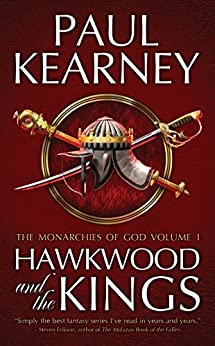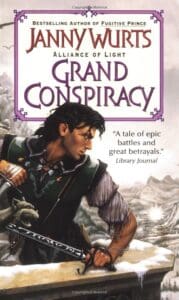Rating: 8/10
Synopsis
THE WESTERN WORLD IS BURNING…
For Richard Hawkwood and his crew, a desperate venture to carry refugees to the uncharted land across the Great Western Ocean offers the only chance of escape from the Inceptines’ pyres.
In the East, Lofantyr, Abeleyn and Mark – three of the five Ramusian Kings – have defied the cruel pontiff’s purge and must fight to hold their thrones through excommunication, intrigue and civil war.
In the quiet monastery city of Charibon, two humble monks make a discovery that will change the whole world.
Aekir, the Holy City, has fallen and all now seems lost, but even on the eve of destruction the Faithful still war amongst themselves…
‘Hawkwood and the Kings’ collects ‘Hawkwood’s Voyage’ and ‘The Heretic Kings’, the first two books in Paul Kearney’s spectacular ‘The Monarchies of God’ cycle.
Review
Monarchies of the God was Paul Kearney’s first jab at telling the traditional fantasy epic and I believe he accomplished an amazing 5 book series. This review is actually for the omnibus of the first and second books in his Monarchies of God series and for a good reason. The end of the first book, Hawkwood’s Voyage, ends on a little bit of a cliffhanger, so you can quickly continue the wonderful story. The story actually works well being published as an omnibus as opposed to standalone books. Paul Kearney’s prose are very rich and descriptive but not over embellished as he has a natural talent for epics. Steven Erikson, one of my favorite writers, described this series as “Simply the best fantasy series I’ve read in years and years.” So, I had to see what all the fuss was about.
Hawkwood and the Kings is a definitive fantastical parallel to the Western Schism of the Christian church as well as the quest for the New World and the fall of Constantinople. It’s a story of religious and cultural strife between the Ramusians (Christians) and the Merduks (Muslims). Even the map resembles Europe, but this does nothing to affect the ability of Kearney to tell a compelling story and it doesn’t deter from enjoyment I had with these characters. The novels are heavily influenced by religious strife and the holy crusades struggling for control, but it is done in such a mesmerizing and intense way that I had to keep reading the next page.
The books starts with the fall of the holy city of Aekir to the Merduk horde. The crumbling and burning city is described vividly and we are introduced to our first main character, Corfe. Corfe is a soldier who has suffered tremendous loss by the Merduk. His wife is believed dead in the fall of Aekir, his friends dead, his home burned. His arc is something of a cross between a tale of redemption and one of trudging along to wherever his feet take him because he has been so numbed by his loss. What Corfe doesn’t know is that his wife is alive and captured by the Merduks and becomes one of the concubines to the Merduk leader. The sense of loss and grief between these two characters was so emotional and tragic but with a glimmer of hope that they will find each other again. Corfe is that one character who will stick with you many years from now.
We also have the mariner Richard Hawkwood, who is tasked with captaining a settling journey to the lands of the west. Believed to be uninhabited, he goes on a voyage to discover the forgotten lands. Fans of sea travel voyages will love this part of the story and its also some on the more haunting scenes you will read as I recollect.
King Abeleyn of Hebrion is the typical young king, ignorant at times and a little bit full of himself. The Ramusian church, after the fall of Aekir, conducts a series of purges of all who are not Ramusians and members of the Five Kingdoms. As well as Dweomer-folk, or magic-users, in Abeleyn’s kingdom without his consent, and his story revolves around strife with the Pontiff and internal conflict in his kingdom. These three story lines drive the story to the conclusion of book 2 and concludes in the Monarchies of the God Volume 2.
One more thing we need to discuss is Paul Kearney’s treatment of his characters. He is unapologetic in how he treats his characters throughout the series to the point where you could consider it pure brutality. He will not hesitant to kill off any character in order to drive his story and I ate it up! The first book in this series was published in 1994 and apart from George R.R Martin this type of writing was not very popular. Grimdark fantasy had not sunken it claws into the SFF world and because of this I believe the books didn’t become a household name. However, this is a new generation who loves complex, dark, and mysterious stories for our consumption.
Fans of A Song of Ice and Fire, Malazan, or if you are a history buff on religion and the crusades, this should appeal to you. This was my first dive into Paul Kearney’s work and I have no intention of stopping anytime soon!
Cheers!





Leave a Reply